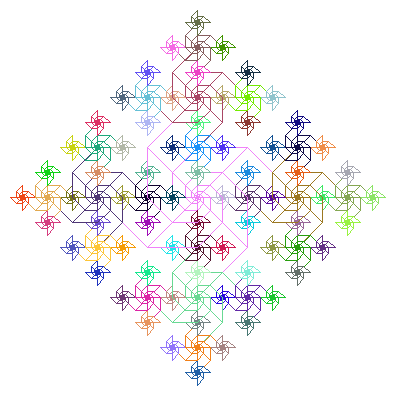After Saturday’s post on using turtle graphics to draw letters, I wanted to get back into drawing some fractals. Fractals are cool.
In particular, there’s this one fractal that I always used to draw in middle/high school by hand. It got a little complicated after a few iterations, but it was a good way to keep my hands busy during class. Anyways, without further ado, here’s what I’m trying to generate:

Sort of a combination star/snowflake/spirally thing. In any case, it turns out the code to draw it isn’t actually that terribly complicated:
(define (draw-star! t d n)
(let loop ([d d] [n n] [skip 5])
(set-pen-color! t (color (random 256) (random 256) (random 256)))
(when (> n 0)
(turn-to! t 0)
(repeat 4
(turn! t 90)
(when (not (= (mod skip 360) (mod (turtle-direction t) 360)))
(block t
(move! t d)
(let* ([d2 (* 0.5 (sqrt 2) d)])
(block t
(turn-and-move! t -135 d2)
(turn-and-move! t -90 d2)
(move-and-turn! t (- d2) 45)
(let loop ([i 10] [d3 (* 0.5 (sqrt 2) d2)])
(when (> i 0)
(move-and-turn! t d3 -45)
(loop (- i 1) (* 0.5 (sqrt 2) d3))))))
(loop (/ d 2) (- n 1) (+ 180 (turtle-direction t)))))))))
Perhaps the most interesting bit is the variable skip. The goal is that when you expand out in a direction, you only recursively expand in the three directions other than the one you came from. If you take out the skip code, you get something more like this:

Still neat, but not what I was going for. As a side note, I started with (= skip 5) basically because none of the branches are going to be at 5 degrees. Originally, I started with skip as #f, but that didn’t work so well with =. So it goes.
I used a few helper functions to shorten the turn/move blocks, but they’re obvious enough (I’m actually considering adding them to the API though):
(define (turn-and-move! t turn move)
(turn! t turn)
(move! t move))
(define (move-and-turn! t move turn)
(move! t move)
(turn! t turn))
To draw it, this is all you need:
(let ([turtle (hatch)])
(draw-star! turtle 100 4)
(draw-turtle turtle))